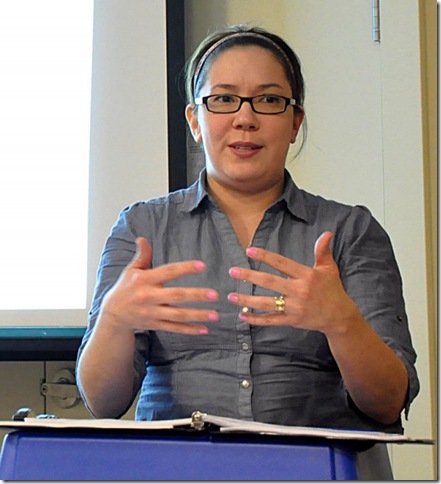Secwepemc lawyer Katrina Harry spoke at the Gathering Place last Wednesday night. She presented her research on the history of the Indian Act and how it has negatively affected First Nations in Canada, particularly women.
PHOTO BY SARAH MAKOWSKY

By Sarah Makowsky:
The Indian Act of 1876 created social consequences and undermined the roles of First Nations—particularly women—in Canadian society, according to Secwepemc lawyer Katrina Harry.
Her talk at the Gathering Place last Wednesday evening was part of the International Women’s Day celebrations held all week on campus.
“I’m talking about a topic that’s very near and dear to my heart,” said Harry, who’s part of the Esketemc First Nation in Alkali Lake, near Williams Lake.
She presented the paper she was asked to write by Battered Women’s Support Services in Vancouver. It’s about how the Indian Act has impacted First Nations communities, particularly women.
Apart from showing her findings, Harry wants to create a dialogue and have people “reflect on how different Aboriginal people exist compared to other in society.”
Harry noted that she uses the terms aboriginal, First Nations, Indian and indigenous interchangeably and doesn’t mean to offend anyone with these words.
Although native women have been marginalized, she said, “It doesn’t diminish the strength that they’ve had over the past 130 years. They’re warriors, not victims.”
She reinforced this by opening with a video of 90 Aboriginal women in 1981 occupying the Department of Indian Affairs, now known as Indian and Northern Affairs Canada (INAC). They were concerned over the future of First Nations in Canada.
They were served papers by the sheriff asking them to leave, but held their ground and wouldn’t depart until they were heard.
“It’s an opportunity to work and learn and change things for the future,” said aboriginal student representative Nicole Cahoose Joseph.
Harry shared some statistics released in 2000 stating that Status Indian women could expect to live five-and-a-half years less than women in Canada. The suicide rate among First Nations is also three times the national average, she said.
The roles of First Nations women differed from those of the European women who settled in Canada, said Harry. The latter were confined to the house, tied to domesticity and their husband whereas First Nations women enjoyed personal autonomy.
“People started figuring out how to control Indian Peoples,” said Harry, even before the Indian Act was enacted. The government developed a categorizing and labelling system that caused First Nations to quarrel amongst themselves.
The government thought that dividing and conquering was the best way to break Aboriginal Peoples down and assimilate them into society, which was the ultimate goal.
When the Indian Act passed in 1876, it appointed the federal government as legal guardian over First Nations People. The Act also brought about the term “Status Indian”, which meant that those who proved they were of Aboriginal heritage had to carry an identity card.
To this day, said Harry, this is the only legally created race-based identity card in the world. And until recently, Status could only be proven through male lines of inheritance.
People had to renounce their status if they obtained a university degree, joined the military or lived abroad for five years, among others things.
“It’s like we’re not people in the eyes of the law,” said Harry. “The plan was to repress Indians, reduce independence and control their lives.”
There was a time when First Nations were not permitted to kill their own livestock and were banned from using mechanical farming tools.
“Their treatment was inhumane,” said Harry.
Women were even more marginalized because the loss of their Indian Status was a constant threat. They had to renounce their status if they married a non-Aboriginal or had to leave their band and join her husband’s if she married. If they divorced, she would have to apply again to be in her band.
“The Indian Act chipped away at women’s positions in communities,” said Harry.
Harry’s research is available here.
Katrina Harry serves as a member of BWSS Board of Directors





wow thank for the excellent read, i love statistics, and you definitely covered all your bases